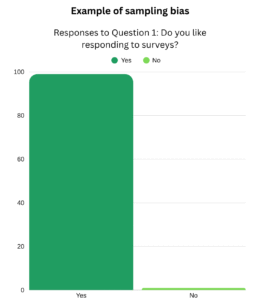Sampling Bias | Definition, Types & Examples
Because collecting data from every single individual in a population is often difficult or even impossible, researchers typically study a smaller group known as a sample. If the sample accurately reflects the broader population, findings from the sample can be generalized to that population.
However, selecting a truly representative sample isn’t easy—some individuals may be more likely to be included in a study than others. Sampling bias occurs when the sample differs from the population in a meaningful way. This difference can distort study results and lead to inaccurate conclusions.
Types of sampling bias
There are several different types of sampling bias. The sections below review some common ones: self-selection bias, nonresponse bias, healthy user bias, survivorship bias, undercoverage bias, and prescreening bias.
Not all types of sampling bias will be relevant in every situation, and they are not mutually exclusive—multiple types can occur at the same time. Whenever you are collecting data from a sample, carefully consider which forms of sampling bias are present and how they could influence your results.
Self-selection bias
Definition: When individuals can choose whether or not to participate in a study (which is a research ethics requirement when studying human participants), some types of people are more likely to self-select than others. As a result, the sample may have characteristics that differ from the general population, leading to unrepresentative results.
Though the mice in this study do not volunteer to participate per se (as human participants would), those brave enough to enter the traps are essentially self-selecting. Their subsequent activity levels may not reflect the behavior of more timid or cautious mice.
Nonresponse bias
Definition: Sometimes, participants who are unable or unwilling to participate in a study share specific characteristics. When these individuals differ systematically from those who do respond, study results may be biased. Nonresponse bias is closely related to self-selection bias.
Healthy user bias
Definition: The people who are willing to volunteer for a study or participate in a program (such as a clinical trial) are often healthier or more health-conscious than individuals in the general population. This bias may lead to overestimation of the effectiveness of an intervention or treatment. Healthy user bias is a type of self-selection bias.
Because these individuals are eager to engage in healthy behaviors, the results show a large drop in cholesterol. The general population is less likely to experience this result, leading to an overestimation of the diet’s effectiveness.
Survivorship bias
Definition: A dataset may only include observations that pass some selection process, such as those surviving, succeeding, or remaining in a system. Survivorship bias can lead to overly positive or skewed findings because failures or dropouts are systematically excluded.
This bias may result in incorrect conclusions about which accidents are most common or factors that influence survival.
Undercoverage bias
Definition: Undercoverage bias occurs when a subgroup of the population is systematically excluded from a sample. This can result in research findings that don’t reflect the needs or opinions of the full population. This type of sample bias is common in non-probability sampling methods such as purposive sampling.
However, by using landlines, the researchers leave out people who rely on mobile phones (like younger or low-income voters). The polling results may therefore overrepresent the preferences of older or more traditional voters and fail to predict the actual election outcome.
Prescreening bias
Definition: Prescreening participants helps researchers focus on the right population—for example, if you’re studying loneliness in seniors, it makes sense to exclude young adults. However, overly strict criteria can exclude important perspectives or experiences, resulting in prescreening bias.
Prescreening bias can also be introduced by the method of recruitment. For example, advertising only on social media will exclude anyone who does not use those platforms.
However, this decision systemically excludes people who take medication to manage their mental health, resulting in findings that may not generalize to everyone in the population.
Although prescreening is often necessary to collect “clean” or usable data, it is crucial to consider how these decisions might affect the interpretation of your findings.
How to avoid sampling bias
While sampling bias can’t always be eliminated, you can take steps to minimize its impact.
- Choose your sampling method carefully: Compared to other sampling methods, simple random sampling minimizes sampling bias, as everyone in the population has an equal chance of being included; however, it’s not always practical. Convenience sampling and purposive sampling are easier but are more prone to sampling bias.
- Clearly define your target population: Identify who or what you want to study and which characteristics matter for your research (e.g., age, gender, race, education, health). Choose a sampling method that enables representation of all relevant subgroups.
- Use an up-to-date sampling frame: Probability sampling requires a sampling frame (a list of all members in the population). An outdated sampling frame can miss key groups and lead to sampling bias.
- Monitor your sample in real-time: As you recruit participants, track key demographics. If certain groups are under- or overrepresented, adjust your recruitment strategy.
- Make your study easy to complete: Long, complicated, or uncomfortable studies may increase dropout. Pilot test with colleagues, provide clear instructions, and ensure accessibility for your target audience.
- Provide fair compensation: Be transparent about how participants are compensated (e.g., financial compensation, course credit, the chance to win a prize) to encourage participation.
- Follow up with nonresponders: A simple reminder can reduce nonresponse bias by catching anyone who missed the initial invite.
- Use oversampling when needed: If a group is underrepresented, consider sampling them at a higher rate. This overrepresentation can be corrected by reweighting this group’s data to reflect the actual population.
Real-world sampling bias examples
Sampling bias isn’t just a theoretical issue—it’s present in a lot of real-world research. This section outlines some memorable examples of how biased sampling can impact research findings.
Overreliance on WEIRD samples has led to results that don’t always generalize to other groups. For instance, Mary Ainsworth’s research on caregiver–child attachment was based on middle-class American families and doesn’t necessarily apply to children raised in non-Western or communal cultures.
When interpreting any research findings, it’s important to consider how sampling bias might limit the broader applicability of the results.
While psychology research has long been impacted by overreliance on WEIRD samples, sampling bias has also played a role in more contemporary medical and public health research.
They tested two different advertisements to recruit participants for a survey about COVID-19 attitudes. The first advertisement asked people to share their views on Canada’s response to COVID-19, whereas the second asked people to share their views on Canadian healthcare more generally. Both ads linked to the same COVID-19 survey.
The results indicated that people who responded to the COVID-19 ad were more likely to express concern about the virus compared to those who saw the general health ad.
This research demonstrates how even subtle differences in how a study is advertised can change who responds and, consequently, what the data seem to show.
Frequently asked questions about sampling bias
- What is sampling?
-
Sampling is the process of selecting a subset of individuals (a sample) from a larger population.
Because it’s often not feasible to collect data from every individual in a population, researchers study a sample instead. The goal is to use this sample to make predictions (or inferences) about the broader population.
For example, if you want to study consumer attitudes towards a brand, you might survey a subset of customers rather than every single one.
There are different sampling methods that can be used to select a sample.
- What is the difference between sampling bias and selection bias?
-
There’s not a universally agreed-upon distinction between sampling bias and selection bias, but sampling bias is often considered a subtype of selection bias.
Sampling bias occurs when a sample is not random (i.e., it differs from the target population). It impacts external validity—how well the results generalize from the sample to the population.
Selection bias, on the other hand, refers more broadly to bias introduced when selecting who to include in a study. It impacts internal validity—whether your results can be explained by the independent variable you manipulated (and not by other confounds).
The distinction between sampling and selection bias is complex. AI tools like QuillBot’s Paraphrasing Tool can be helpful when trying to parse difficult concepts.
- What are some types of sampling bias?
-
Sampling bias occurs when the sample collected for a study systematically differs from the target population. Below are some common types of sampling bias:
- Self-selection bias: People who choose to participate in a study differ from the general population in an important way (e.g., motivation, interest).
- Nonresponse bias: Those who are unable or unwilling to respond often share key characteristics, and their absence may skew results.
- Healthy user bias: Individuals who are able or willing to participate are often healthier or more health-conscious than nonparticipants.
- Survivorship bias: Data are only available for individuals or outcomes that pass a certain filter (e.g., those who survive an event); those that didn’t are ignored.
- Undercoverage bias: Certain subgroups are systematically excluded from the sample, leading to skewed representation.
- Prescreening bias: Eligibility criteria (e.g., age, language) may unintentionally exclude relevant parts of the population.
Not sure which types of sampling bias are applicable to your study? AI tools are a great way to generate ideas and receive dynamic feedback on study design. Try QuillBot’s free AI Chat the next time you’re feeling short on inspiration.
- How do you avoid sampling bias?
-
Though it’s difficult to fully eliminate sampling bias, it can be minimized through careful research design and sampling methods.
Probability sampling methods (where every member of the population has a known chance of being selected) are less susceptible to sampling bias than nonprobability methods.
Looking for ways to minimize sampling bias that are tailored to your specific situation? Get ideas from QuillBot’s free AI Chat.
Cite this Quillbot article
We encourage the use of reliable sources in all types of writing. You can copy and paste the citation or click the "Cite this article" button to automatically add it to our free Citation Generator.
Heffernan, E. (2025, July 22). Sampling Bias | Definition, Types & Examples. Quillbot. Retrieved August 11, 2025, from http://qbot.seotoolbuy.com/blog/research/sampling-bias/

